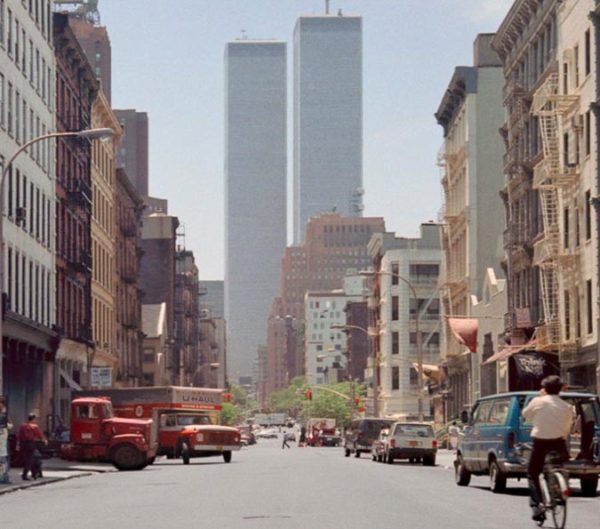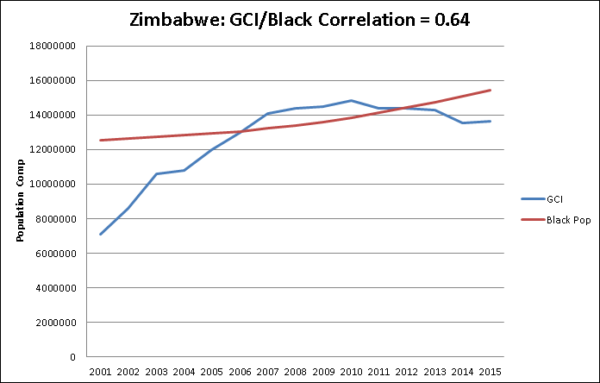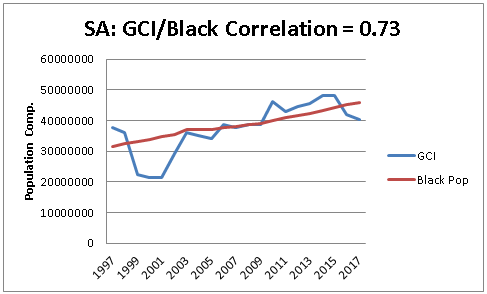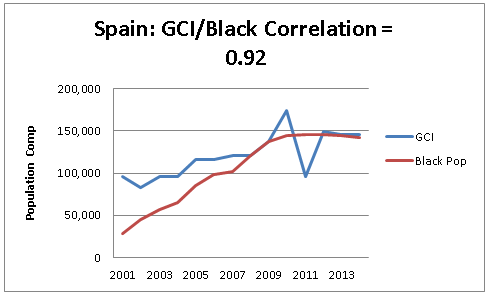Effect Of A Black Population On Competitiveness
Every truth goes through three stages: it seems impossible, it seems laughable, and then it becomes normal. Information floating across my table sometimes causes me to ignore it at first, because it seems really far-fetched.
But in some instances, it then becomes clearly more true than not, which is how we qualify “truth,” as a heuristic approximation of reality that is a work in progress. This graph almost had me dismissing it out of hand, but then, a second look revealed its importance:
The graph attempts to show a correlation between the Global Competitiveness Index (GCI) and the growth of the black population in Zimbabwe over time (higher values indicate a less competitive economy).
If the two graphs are put together, one can visualize the data demonstrating a correlation between them. Essentially it points to the idea that the more people Zimbabwe has, the less competitive it becomes. Before you say it is all due to the failure of leadership in Zimbabwe, notably by Sir Robert Mugabe, let’s look at South Africa:
For some strange reason the same trend appears in a country spawned by President Mandela. But most people would agree that Mandela was not Mugabe and we must consider that that the two economies are radically different, with Zimbabwe being an emerging economy and South Africa at least officially a first world nation. The commonality between them however, is that both countries were British colonies and that their majority demographic are sub-Saharan black ethnic peoples.
In order to get a broader perspective, it makes sense to compare these charts to those of an efficient first-world country:
In Spain, the black population is a significant minority, but still the correlation seems to increase. We may still be uncomfortable making a causal connection of this correlation, however, because other factors affect the productivity of an economy, which is why the CGI report takes into account hundreds of parameters.
So let’s look at the bastion of productive economies: America. The data is there but is too coarse for a sensible graph. Using the same method as above, the US GCI/black population correlation appears to be 0.59. However, the US is highly sensitive to changes in its CGI ranking; the correlation would increase to 0.64 if the 2017 final ranking is 4th place (it is now estimated at 3rd place). This means that the USA GCI/black correlation will rapidly increase if American GCI rankings drop.
What this means is that the more black people you have in a population, the less competitive that population is. The GCI indicates not just financial competitiveness, but has other implications including how well the institutions of that society function, and thus, what its future is going to look like. Low competitiveness societies are third world or heading toward it rapidly.
Since the data matches between these three nations, and we can see how the ranking dramatically effects the accuracy of the data, it is important to realize the time factor here: a society which once had functional institutions, but now is in dysfunction, will not show that dysfunction for many years because the people who make those institutions work are holdovers from the past.
Once those people go, the GCI ranking drops, and then we see the same pattern. I first laughed off this data because it is an absurdly simple concept, that the more black people your society has, the less competitive it is. However, I came to see that it is real, but wanted to raise a few other points.
First, this does not necessarily imply that the problem is black people themselves, because in former colonies and the first world, black people are a proxy for diversity, or the destructive habit of mixing multiple ethnic groups in the same society, which lowers social trust and because of that will make all social institutions less functional, which in turn lowers competitiveness. However, it seems likely that the effect is more pronounced with black people, so it is possible there are dual effects: (1) a lowering of social order with diversity and (2) the more “different” the diverse population, the greater the damage to competitiveness as a proxy for social function.
Second, this will probably be addressed by another aspect of social order. Diversity, like apartheid before it, is unpopular as of the second term of the Obama presidency in the USA. It became clear that even having a black president was not going to heal old wounds, and racial tensions intensified rather than decreased. The great middle class dream for all problems to just “go away” so that the middle class could focus on its careers, hobbies and television has failed; problems, like risk, must be managed or the overwhelm the organization around them.
While in practice the Trump administration is changing its macro approach in order to strengthen the US economy, note should be taken of what happens at micro-level too, such as demographic changes in the population and the degree of interpersonal friction and thus lowered communication they create. In addition, the Hispanic effect on the US economy is far from certain because of the unpopularity of even thinking about these effects, but if a group that is more diverse has a wide impact, the Hispanic impact on competitiveness is most likely to lower it as well.
It is undeniable that Americans are walking with open-eyes into the future thinking that becoming a minority is cool. Since the current US majority views its minorities with empathy and a helping hand, the question becomes what blacks will do once they become the majority in 25 years.
And following that: what they will do once they become replaced by Hispanic and then Asian majorities, as demographic trends indicate will be the sequence. When white people are a quarter of the American population, and other ethnic groups are dominant both in numbers and in positions within the system, we are facing an entirely different competitive landscape, because any diversity demerit to competitiveness will be increased manifold.
Given the apparent drop in productive economies due to sheer black numbers, the answer requires not only an in-depth investigation, but also the cultural question only blacks can answer: do blacks want whites around at all? If history teaches us anything, it is that diversity of any form — even ethnic and religious diversity — is a constant source of conflict which reduces the effectiveness of a nation.
The research of Martin van Crefeld indicated that even strong majorities cannot withstand sustained minor conflicts. This applies to black majority countries as well, and any majority presence of over about 20% seems to trigger constant internal conflict, like inflammation in the body. Interestingly, in Africa there is no clear majority tribe.
Africa may then point us toward a future vision: a world without a majority, where the minority groups are so many that none dominate except in a local area, but also, because there is no possibility of collaboration, long-term infrastructure becomes impossible and invasions by foreign powers will be successful as they roll up the discoordinated local areas much like the settlers in the US conquered the Amerinds.
In any case, the immediate data is clear: having black people, and diversity in general, damages the competitiveness of your country. With that comes a host of other problems, including lack of internal standards and reliability, and through that, a lack of ability to respond to its external world, which is always a sign that collapse is imminent.
Tags: african-americans, africans, competitiveness, diversity, global competitiveness index













